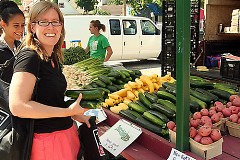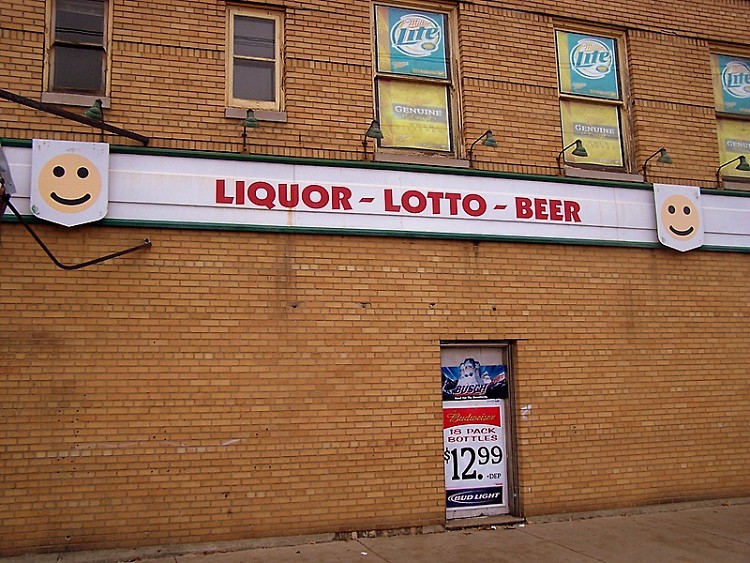By: Marie Roper, Naomi Jackins, Taylor Libolt, Katie Burkley, and Amanda Granger
Over the past 50 years, access to healthy food has become more dispersed due to urban sprawl and the development of mega-grocery stores. These mega-grocery stores tend to locate where land is available, far away from those who lack transportation to get there. In West Michigan today, the primary place to buy produce and other healthy foods is a Meijer or Spartan Store, most of which are located in middle-class neighborhoods and suburbs. This creates the problem of food deserts.
Food deserts are areas within a city where access to fresh and nutritious food is minimal or absent altogether. Deserts are typically found in low-income areas where the majority of residents lack adequate transportation. According to 2009 USDA research on access to affordable nutritious food, 2.3 million United States residents live more than a mile from a grocery store and do not have access to a vehicle. A representative U.S. household survey in 2001 concluded that about 6% of all U.S. households did not always have the food they needed due to access problems.
Many low-income areas have limited access to fresh supermarkets that sell items such as fruits, vegetables and lean meats, forcing people in these areas to shop at convenience stores and fast food chains, which sell high-fat, high-sugar, processed food and have few cheap and healthy options. For example, according to the January 2011 report from Michigan Good Food, higher numbers of convenience stores are found in urban areas than grocery stores, especially in low income areas.
If you drive down Division you will see this statement clearly illustrated. You will observe a convenience or party store every couple of blocks and no grocery store in sight. As a result, it becomes easier for people to spend money on processed food at a convenience stores down the road than it is to travel to Meijer out on Alpine for produce.
In Grand Rapids, neighborhoods such as Heartside and Baxter have minimal access to healthy food.If you search "Grand Rapids grocery stores" on Google maps, you can see that the Heartside neighborhood only has one grocery store within 2 miles and it is Grand Central Market. Grand Central Market is a great store, but it is relatively small for the amount of people living downtown. It also offers more specialty items at a higher price.
When viewing the Baxter neighborhood on Google maps, one can see that Wealthy Market is closest grocery store and Family Fare is nearly 1.5 miles away. However, because of the increasing demand for healthier food options, some stores in the area are making efforts to meet these demands. In the past two years Wealthy Market, a grocery store located on Diamond and Wealthy, has made efforts to improve their store by offering fresh produce, something they did not offer previously. When they underwent the change, Wealthy Market spread the news to surrounding areas through flyers.
Private organizations are also putting effort into increasing healthy food options in Grand Rapids. The Inner City Christian Foundation (ICCF), a private organization closely tied to housing and city development in Grand Rapids, is currently working on building an urban revitalization project on Wealthy and Jefferson. Jonathan Bradford, president and CEO of ICCF says that one of the first questions asked during the planning process of the Wealthy-Jefferson development was, “What does a healthy community look like?” They identified one of the main factors in a healthy community as adequate access to healthy food. Further research identified the Wealthy-Jefferson area as one of the primary areas in need of urban grocery.
School psychologists in the area observed connections between low student performance in schools and lack of nutrition. Bradford spoke of a mother in the area who could only afford to go to one of the large grocery stores like Meijer once a month and for the rest of the month her children would eat from the local party store on Franklin. These types of stories and observations are common among underserved areas.
The plan for the Wealthy-Jefferson project includes a 30,000 square foot grocery store located on the corner of Wealthy and Division. Taylor Voss, manager and core team member for the forthcoming store, says that competitive pricing and financial instability are some of the main challenges for individually owned grocery stores. Urban grocery stores simply cannot get the volume of goods through the store that is needed to keep prices low. Voss maintains that “people still go for prices.” Because of this, Bradford says that one of the goals for the grocery store will be to educate people on food and build relationships in the process. To address the problem of financial instability, the Wealthy-Jefferson grocery store will have key partnerships with several other local organizations, including ICCF.
Another way neighborhoods in Grand Rapids have been approaching the food access problem is by shopping at farmer’s markets. The increasing volume of people using the Fulton Street Farmers Market has lead to the market creating an entirely new facility in the same location. There are other plans to build an Urban Market downtown around the Heartside neighborhood. The Urban Market would include a place for local farmers to sell their goods, as well as areas for food and nutrition workshops and local retail options.
Grand Rapids residents have also been focusing more on growing their own food, whether independently or in a community setting. Our Kitchen Table is a local organization that focuses on educating individuals, families and communities on how to grow their own food. They regularly hold workshops and cooking demonstrations to encourage people to share experiences, recipes and ideas with the community.
How do you get your food? Do you travel to a suburban supermarket, use convenience stores, go to farmer’s markets, go straight to the farmer or grow your own? Is quality okay to sacrifice for price or quantity? How do we make a city great and how do we approach problems of malnutrition? Healthy and accessible food appears to be one of the solutions.
The Rapidian, a program of the 501(c)3 nonprofit Community Media Center, relies on the community’s support to help cover the cost of training reporters and publishing content.
We need your help.
If each of our readers and content creators who values this community platform help support its creation and maintenance, The Rapidian can continue to educate and facilitate a conversation around issues for years to come.
Please support The Rapidian and make a contribution today.


